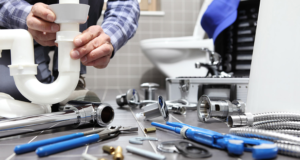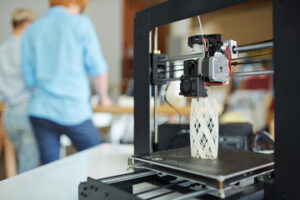A lush, green lawn can transform your property and help you enjoy the outdoors. A well-manicured lawn requires mowing, watering, fertilization, overseeding, weed control and tree and shrub care throughout the year.

A soil test provides valuable information about your yard’s nutrient levels and pH balance, which can help your grass thrive. Soil amendments such as lime, compost and topsoil can improve conditions. Click https://www.primecutlawnky.com/ to learn more.
There are a lot of things you can do to improve the health and appearance of your lawn. Mowing regularly, watering frequently, and fertilizing are some of the more obvious lawn maintenance tasks you can perform to keep your grass green. But aerating and dethatching are two important lawn care activities that many homeowners overlook.
The lawn thatch layer is a collection of interwoven accumulated dead grass shoots, stems, crowns, and roots that creates a barrier between the soil and new grass growth. A thin layer of thatch is normal, but when it becomes too thick, the layer inhibits the flow of nutrients, water, and air to the roots and makes the ground feel spongy underfoot. Dethatching is a mechanical process that removes the inhibiting layer of dead grass for a healthier, greener lawn. It can be done manually with a dethatching rake or using an electric power rake. Dethatching is best performed in cool seasons when the days are chilly, morning dew is present, annual weeds have died, and the ground is dry enough to work.
Aeration is a treatment that pokes holes into the lawn to allow for better air flow, water absorption, and nutrient uptake. Performing this treatment in the proper season will improve the overall condition of your grass and ensure it has the best chance of thriving. Aerating and dethatching can be done simultaneously to help revive a wilting lawn, but it is important to do the thatching first and then aerate the lawn to avoid doing more harm than good.
Aerating and dethatching are both labor intensive, but the benefits can be dramatic if you do them correctly. If you’re not willing or able to tackle these lawn maintenance tasks on your own, hiring a professional lawn service is the way to go. A professional can ensure that your thatch and aeration needs are met in the right order and at the best time of year to get the most bang for your buck. If you’re interested in learning more about the benefits of dethatching, aerating, and seeding as part of your lawn care regimen, contact The Grounds Guys. We can give you a free estimate for our services and help you achieve the lush, beautiful lawn you’ve always wanted!
Irrigation
An irrigated lawn is one of the best ways to keep your property looking its best. It is also an excellent way to conserve water because it helps your grass retain its moisture longer, thereby reducing the number of times it needs to be watered.
A good irrigation system allows you to schedule your watering according to your region’s weather and rainfall patterns. It will automatically turn off when it rains, preventing you from over-watering and wastefully wasting money.
Irrigation services can include the installation of an underground system that includes a series of sprinklers or spray heads that are connected to an irrigation controller. A good irrigation system will also include a rain sensor to prevent the irrigation from turning on during precipitation.
Lawn care includes a variety of services that help the grass, shrubs and trees around your home look healthy and beautiful. The most basic lawn services are mowing, fertilization and weed control. However, it is also important to perform other services, such as aeration and dethatching, to ensure that the soil of your property is healthy and conducive to growing grass.
Aerating and dethatching help to alleviate soil compaction and thatch buildup, allowing air, water and nutrients to reach the grass roots more easily. These lawn care services are also important to aerate and dethatch your property in order to reduce the amount of water needed for hydration and promoting healthy, vibrant grass growth.
Watering new sod or transplanted grass is done at a time of the day when evaporation is minimized, typically in the early morning. Watering at other times of the day predisposes the grass to disease and can cause it to overgrow, making the lawn less healthy.
In general, a lawn should be watered deeply once or twice per week. The best way to know when it is time to rewater is by checking the soil to make sure it is moist. Another test is to step on the grass; it is ready to be rewatered when it springs back after being stepped on. Depending on your soil type, you may need to adjust the frequency and depth of your watering schedule throughout the season.
Fertilization
Fertilization provides your lawn with the nutrients it needs to thrive. Regular fertilization makes your grass stronger and healthier, which means it’s better equipped to resist weeds, diseases, pests, and harsh weather.
Your lawn’s best time for fertilization is the spring or fall. This allows your grass to absorb the fertilizer and take it up through the roots. It also gives the roots a chance to establish themselves before winter.
A lawn care professional will know the best time to fertilize based on weather conditions and grass cycles in your area. They can also help you determine whether your lawn would benefit from a specific type of fertilizer. For example, some fertilizers are designed to kill weeds while others are high in nitrogen and promote fast growth.
In addition to applying the right fertilizer at the right time, your lawn care provider will take other steps to ensure your grass gets the most out of it. This includes mowing the lawn properly, dealing with weeds, and testing and adjusting soil pH levels (if needed).
It’s important to note that the proper timing of these lawn maintenance tasks depends on the kind of fertilizer you use. Too much of the wrong kind can harm your lawn, while too little can make it weak and vulnerable to diseases, pests, and weeds. Fortunately, your local lawn service will have all the knowledge and tools to keep your yard looking its best.
When you do need to apply a lawn fertilizer, be sure to give the grass a good watering in advance. It’s also a good idea to wait a few days before mowing, as this will prevent clogging your mower with leftover fertilizer.
If you’re unsure of how to fertilize your lawn, or you simply don’t have the time to do it yourself, talk with your local lawn care specialists. They’ll be able to provide you with a schedule and recommend the right products for your home. They may even offer a money-back guarantee if you’re not satisfied with their services! So give them a call today to get started.
Weed Control
Weeds can be a serious problem that threatens the health and appearance of your lawn. Having regular lawn weed control treatments in place can help eliminate the weeds and prevent them from returning. A healthy lawn can effectively block out weeds because they compete for the same resources: sunlight and nutrients. A good lawn also crowds out weeds by having thick, dense growth that can’t be easily pulled or mowed down.
To successfully implement a weed control program, it’s important to correctly identify the weeds invading your yard or garden. This can help you determine whether or not control measures are needed, as well as the most appropriate herbicide product to use if necessary. It’s also important to understand the causes of increased weed growth, as removing a weed without correcting the underlying issues can only invite more weeds to invade.
If you choose to use herbicides, it’s essential to follow the directions on the product label to ensure safety and effectiveness. It’s also a good idea to wait at least 1 to 4 hours after treatment before mow your lawn. This gives the product time to fully absorb into the weed and kill it.
Aside from using herbicides, there are other weed control methods you can use as part of a broader lawn care program. Tilling, hand pulling, or mowing can be helpful, especially with annual and biennial weeds that reproduce from seed. Perennial weeds can also be controlled by preventing seed set, although this will not eradicate the weed and may only delay its return.
Biological controls, such as pathogens and predator insects, can be used to control some weed species as well. However, these options require a much longer timeline to be effective and can be more expensive.
A combination of lawn weed control treatments and cultural practices is often the best way to manage a weed infestation. A weed control program in conjunction with fertilization will remove the weeds while replenishing your grass’s nutrients. Remember, if you choose to use herbicides, be sure to consult with a professional to ensure that your children and pets are safe from the chemicals and that they are properly applied.








